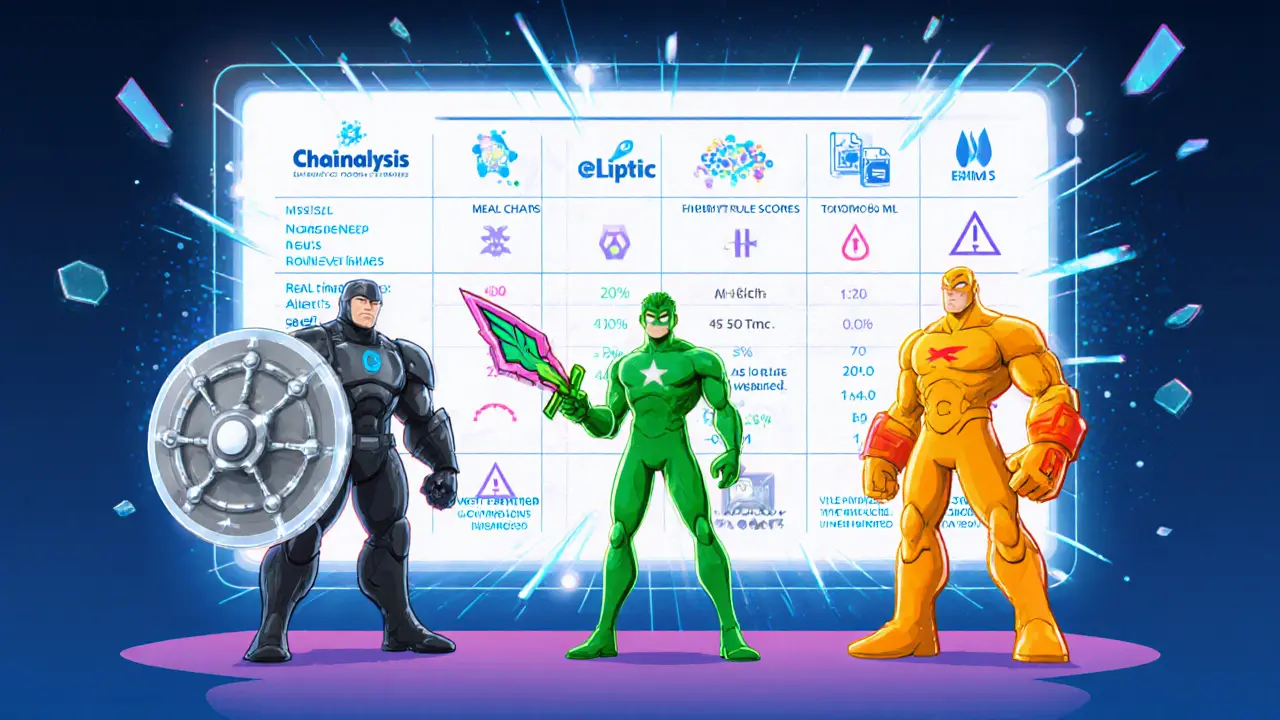- Home
- Cryptocurrency
- Blockchain AML Technology: How Blockchain Analytics Transforms Crypto Compliance in 2025

Blockchain AML Technology: How Blockchain Analytics Transforms Crypto Compliance in 2025
Blockchain AML Platform Comparison Tool
This tool compares key features of top blockchain AML platforms in 2025. Select platforms to compare their capabilities.
| Feature | Chainalysis | Elliptic | TRM Labs |
|---|---|---|---|
| Supported Chains | Bitcoin, Ethereum, Solana, BNB, Cardano | Bitcoin, Ethereum, Polygon, Avalanche | Bitcoin, Ethereum, Algorand, Tezos |
| AI-driven Risk Scoring | Yes (Neural-net based) | Yes (Gradient-boosted trees) | Yes (Hybrid rule/ML) |
| Real-time Alerts | Webhook & dashboard | API streaming | Event-driven notifications |
| Compliance Reporting | SAR generator, AML audit trail | Customizable regulator templates | Integrated case-management |
| Pricing (2025) | US$5k-30k/month (tiered) | US$4k-25k/month | US$3k-28k/month |
Chainalysis
Best for global banks with broad chain coverage and extensive regulatory certifications.
Elliptic
Ideal for mid-size exchanges due to lower entry cost and strong performance.
TRM Labs
Great for institutions requiring flexible integration and hybrid ML approaches.
Recommendation
Based on your selection, consider starting with Elliptic for a mid-size exchange or Chainalysis for a global bank.
When the term Blockchain AML technology is used, it refers to the blend of anti‑money‑laundering (AML) processes with the transparent, immutable nature of blockchain ledgers. In 2025 this hybrid approach is reshaping how banks, crypto exchanges, and regulators spot illicit flows, cut false positives, and meet tightening regulations without drowning in manual reviews.
TL;DR
- Blockchain AML combines ledger transparency with AI to automate crypto compliance.
- Key components: analytics platforms (Chainalysis, Elliptic, TRM Labs), AI/ML engines, and decentralized identity (DID) solutions.
- Adopting a shared KYC consortium can slash compliance costs by up to 50%.
- Future trends: real‑time behavioral analytics, adaptive smart‑contract monitoring, and cross‑chain traceability.
- Implementation steps: choose a platform, integrate AI, join a DID network, and establish data‑sharing governance.
Why traditional AML falls short for crypto
Classic AML tools were built for fiat‑based systems. They rely on static customer profiles, batch‑processed transaction reviews, and manual SAR (Suspicious Activity Report) filing. When a wallet transfers ten thousand dollars of Bitcoin across multiple hops, the legacy system struggles to keep up, leading to two big problems:
- High false‑positive rates: Analysts waste hours chasing benign trades that look odd only because the system can’t see the full flow.
- Blind spots: Without an immutable audit trail, regulators can’t prove where funds originated or whether they passed through high‑risk jurisdictions.
Blockchain AML technology solves both by giving every participant a single source of truth that can be queried in real time.
Core technical stack
The architecture breaks down into three layers that work together like a security fence.
- Blockchain analytics platforms process raw ledger data, cluster addresses, and flag risky transaction patterns. In 2025 the market leaders are Chainalysis, Elliptic, and TRM Labs. They each support Bitcoin, Ethereum, and newer L1 chains like Solana.
- Artificial Intelligence & Machine Learning extends pattern detection beyond simple rule‑sets, learning from millions of historical transactions. Models now flag anomalies such as sudden spikes in transaction velocity from a previously dormant address or funds moving through privacy‑enhancing mixers.
- Decentralized Identity (DID) solutions let users own their verification data, while institutions can query attestations without storing raw personal info. Notable DID networks include Sovrin and uPort.
When these layers talk to each other via APIs, the result is a live compliance radar that can surface suspicious activity within seconds.
Head‑to‑head: Top blockchain analytics platforms
| Feature | Chainalysis | Elliptic | TRM Labs |
|---|---|---|---|
| Supported Chains | Bitcoin, Ethereum, Solana, BNB, Cardano | Bitcoin, Ethereum, Polygon, Avalanche | Bitcoin, Ethereum, Algorand, Tezos |
| AI‑driven risk scoring | Yes (Neural‑net based) | Yes (Gradient‑boosted trees) | Yes (Hybrid rule/ML) |
| Real‑time alerts | Webhook & dashboard | API streaming | Event‑driven notifications |
| Compliance reporting | SAR generator, AML audit trail | Customizable regulator templates | Integrated case‑management |
| Pricing (2025) | US$5k‑30k per month (tiered) | US$4k‑25k per month | US$3k‑28k per month |
All three platforms expose the same core data-transaction graphs, address clustering, and risk scores-but they differ in algorithmic nuance and integration flexibility. A mid‑size exchange might start with Elliptic for its lower entry price, while a global bank could gravitate toward Chainalysis for its broader chain coverage and extensive regulatory certifications.

Implementing blockchain AML in a financial institution
Putting theory into practice is a multi‑step journey. Below is a practical roadmap that works for banks, crypto‑centric fintechs, and even credit unions that dabble in digital assets.
- Assess regulatory scope. Identify which jurisdictions you operate in and map the specific AML/KYC mandates (e.g., FATF Travel Rule, EU AMLD5).
- Select an analytics provider. Run a proof‑of‑concept using two platforms (e.g., Chainalysis vs. Elliptic) on historical transaction data to benchmark false‑positive reduction.
- Integrate AI engines. Deploy pre‑trained models from the chosen platform, then fine‑tune with your own labeled SAR cases. Expect a 20‑30% drop in manual review time after three months.
- Join a DID consortium. Connect to a decentralized identity network such as Sovrin. This lets you verify a customer’s identity once and securely share the attestation across partner banks.
- Establish data‑sharing governance. Use consortium frameworks like R3 or Hyperledger to define who can read or write KYC records. Smart contracts enforce permission rules automatically.
- Automate reporting. Configure the analytics platform to generate SARs in the regulator‑required format, attaching blockchain audit trails as immutable evidence.
- Continuous monitoring & improvement. Set monthly KPI reviews (false‑positive rate, detection latency) and feed new patterns back into the AI model.
Following these steps typically yields a cost reduction of 30‑50% in compliance overhead, according to a 2025 TrustCloud.ai study.
Future directions: What’s on the horizon for blockchain AML?
Even though the technology is already delivering value, several trends promise to supercharge it further.
- Cross‑chain tracing. With the rise of bridges (e.g., Wormhole, Cosmos IBC), AML platforms are building graph engines that follow assets across multiple ledgers without losing provenance.
- Behavioral pattern recognition. Next‑gen AI will combine on‑chain data with off‑chain signals (social media, darknet forums) to spot laundering networks before they move funds.
- Adaptive smart contracts. Contracts can now embed compliance clauses that automatically freeze or flag transactions when risk scores exceed a threshold.
- Regulatory sandbox collaboration. Governments in the EU and APAC are creating shared testbeds where fintechs can trial AML‑blocking features on live chains under regulator supervision.
- Privacy‑preserving analytics. Techniques like zero‑knowledge proofs let auditors verify that a transaction meets AML rules without exposing the underlying details.
These innovations aim to make compliance not just a cost center but a competitive advantage for early adopters.
Common pitfalls and how to avoid them
Switching to blockchain AML isn’t a plug‑and‑play move. Organizations frequently stumble over three issues:
- Data silos. If legacy AML databases stay disconnected, the unified view breaks down. Solution: use middleware that normalizes legacy fields into the blockchain‑compatible schema.
- Over‑reliance on alerts. An AI model that flags every high‑value transfer creates alert fatigue. Solution: calibrate risk thresholds based on transaction volume and incorporate a feedback loop from investigators.
- Compliance‑regulation mismatch. Some jurisdictions still require paper‑based logs. Solution: generate immutable PDFs that embed the blockchain hash, satisfying both digital and paper audit requirements.
Addressing these early saves time and prevents costly re‑engineering later.
Frequently Asked Questions
How does blockchain analytics differ from traditional transaction monitoring?
Blockchain analytics works on a public, immutable ledger, allowing near‑real‑time tracing of every token movement. Traditional monitoring relies on batch imports of fiat transaction files and often misses the full path of funds.
Can small crypto exchanges afford these platforms?
Yes. Most providers offer tiered pricing or usage‑based models. A start‑up can begin with a sandbox tier, paying only for the volume of address queries it needs.
What role does Decentralized Identity play in AML?
DID lets a user store KYC attestations on a blockchain-controlled identifier. When the user opens an account elsewhere, the institution can verify the attestation without re‑collecting personal documents, reducing data exposure.
Will AI eliminate human analysts entirely?
Not completely. AI filters the noise and surfaces high‑risk cases, but a human still reviews nuanced contexts and makes final filing decisions.
How do cross‑chain bridges affect AML compliance?
Bridges create new pathways for funds to hop between ledgers, making a single‑chain view insufficient. Modern platforms now stitch together graphs across Bitcoin, Ethereum, and layer‑2 solutions to preserve audit trails.
Next steps for your organization
If you’re ready to upgrade your AML stack, start with a lightweight pilot: pick a single crypto pair (e.g., BTC/USD), onboard a sandbox analytics account, and run the AI model on a month of historic trades. Measure false‑positive reduction, report generation time, and cost savings. Use those numbers to justify a full‑scale rollout and a partnership with a DID network. The sooner you experiment, the faster you’ll stay ahead of regulators and competitors alike.
Cormac Riverton
I'm a blockchain analyst and private investor specializing in cryptocurrencies and equity markets. I research tokenomics, on-chain data, and market microstructure, and advise startups on exchange listings. I also write practical explainers and strategy notes for retail traders and fund teams. My work blends quantitative analysis with clear storytelling to make complex systems understandable.
Popular Articles
14 Comments
Write a comment Cancel reply
About
DEX Maniac is your hub for blockchain knowledge, cryptocurrencies, and global markets. Explore guides on crypto coins, DeFi, and decentralized exchanges with clear, actionable insights. Compare crypto exchanges, track airdrop opportunities, and follow timely market analysis across crypto and stocks. Stay informed with curated news, tools, and insights for smarter decisions.





Oh, the way blockchain AML tech drapes over the frosted glass of finance feels like watching a tragedy in slow motion, where every transaction is a whispered confession.
This is just hype, nothing new.
Sure, let them hand you the keys to transparency while a hidden cabal watches every move from the shadows, because who needs privacy when the state is already watching?
If you're just starting, focus on integrating the API streams first. That way you catch real‑time alerts before they pile up. Also make sure your risk scoring thresholds match your transaction volume, otherwise you'll be drowning in false positives.
I tell you, the whole blockchain AML narrative is a smokescreen built by the elite to corral the masses into a digital panopticon! Every new AI‑driven risk score is just another algorithmic leash, tightening around our wallets. They say it's about compliance, but deep down it's about control-control of every coin that moves across the ether. The bridges, the cross‑chain trackers, they are not tools for good; they are highways for the surveillance state to spy on our private dealings. And don't even get me started on decentralized identity; it's a Trojan horse, a fake promise of self‑sovereignty while the data ends up in a government vault. Wake up!
Our nation can't rely on foreign analytics, we must build home‑grown AML tools now.
Think of the blockchain as a river; AML is the dam that guides the flow without stopping it, allowing us to see hidden currents while preserving the water's purity.
The integration of zero‑knowledge proofs could revolutionize privacy‑preserving AML, allowing auditors to verify compliance without exposing transaction details, a true win‑win for regulators and users alike.
While they boast about global platforms, we must remember that true security comes from protecting our own financial sovereignty.
Great point! 🌟 Remember, when you set up alerts, test them with a few low‑value transfers first – it saves headaches later! 🚀
Look, if you think a single AI model can replace a seasoned analyst, you might be chasing a mirage.
Consider the compliance timeline when planning integration.
Esteemed colleagues, please be advised that the deployment of AI‑driven risk scoring should be accompanied by rigorous validation protocols, lest we compromise systemic integrity.
👍 Got it, thanks for the heads‑up!